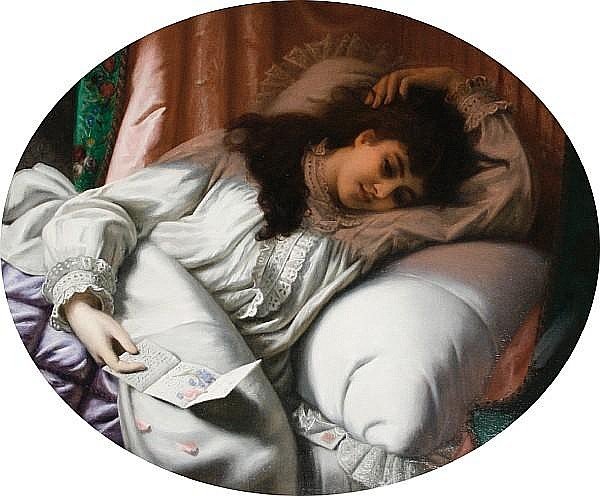William Milton Hay (1830/31-1898)
Eastern Beauty, c1882
Oil on Cardboard, 355 x 295mm
Though it is common to find talented female pre-Raphaelites in the shadow of more famous husbands, it is rarer to find a husband completely eclipsed by his wife.
The following painting recalls the works of artists such as Semenowsky and Portaels. It depicts an eastern beauty or “odalisque” of the Harem, who by the time this was painted (c1882) were normally Circassians from the Caucasus, the impoverished, displaced people, that felt their daughters would fare better as slaves in the Ottoman Empire.
Until recently William Milton Hay was known as “W M Hay” and by vague dates, alluding to an active period. Charlotte Yeldham’s research reveals he was born in 1830 or 1831, died in 1898 and was the husband of Jane Benham Hay (1829-1904), whose dreams of a “beautiful sisterhood in art” came two years after the pre-Raphaelite Brotherhood first met in 1848. Their marriage produced a son, but lasted just a few years before she left for an Italy better able to satisfy her artistic longings.
What can we conclude from his extant works? Generally they are small and painted on millboard. Some look as if they belong to a less ambitious artist than others.
A “Girl of Madeira”, painted on an expensive 6ft roll of canvas and by far his largest, was exhibited at the Royal Society of British Artists in 1868. A reviewer suggested it was hung in the “worst light” and far “too high.” He advised him “to find some other locale in which his genius may be tested more appropriately.” The decisions of a hanging committee rarely cross the mind of later historians, but they do have a bearing on artistic success. Hay’s misfortune of having his magnum opus hung in a place where it wouldn’t be seen must have been especially hard for an artist who is described as a “boarder” in the census of 1861 and 1871. The range of his subjects, the inconsistency of their quality would also suggest a painter aware of the daily pressures; as would the 5 different Bloomsbury addresses given during his appearances at the Royal Academy from 1855 to 1877.
Hay’s southern European subjects suggest that he did travel, possibly through his father-in-law’s company, which imported wine and brandy. The dark-featured model with straight-nose frequently features in his paintings from the 1860s right up until the 1880s.
“Mr. W. M. Hay exhibits the largest and most creditable work he has ever previously sent to Suffolk-street [Royal Society of British Artists]… "A Girl of Madeira;" but… we advise him in future to find some other locale, in which his genius may be tested more appropriately… the "hanging committee" determined to destroy every chance this picture… had of being of the most remarkable features of this year's exhibition. Not only is it pushed aside into the South-West Room, when it ought to have been in the largest apartment, but it is placed in the very worst light that could have been chosen... In consequence of this injustice all the labour Mr. W. M. Hay has been at is comparatively lost. We have no hesitation in saying… that if this picture had been sent to Trafalgar-square [Royal Academy], it would have been so placed as to have given Mr. W. M. Hay a fair chance of rising to a position in that great national institution.
Bell’s Weekly Messenger - Saturday 11 April 1868
Harem Beauty, 1882 - Emile Eisman Semenowsky (1857-1911)
Oil on Panel
Sotheby’s New York, 18 April 2007
“Love’s Young Dream”1880 - WIlliam Milton Hay
Oil on Canvas
Christie’s London, 8th June 2006.
"A Girl of Madeira”, 1868 - William Milton Hay
Oil on Canvas, 173 x 114cm
Sotheby’s 17th September 2002



